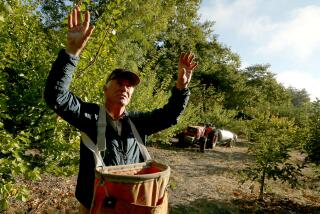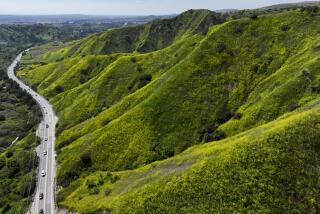For the Central Valley, Too Much of a Good Thing
- Share via
When it comes to farming, rain is typically a good thing. The rains this year, especially in Central and Northern California, are turning out to be a different story.
Heavy and seasonally late precipitation have left farmers scrambling to save a large portion of the hay crop, have disrupted the planting of tomatoes for ketchup and pizza sauce and could reduce the quantity of fresh peaches and other fruits available this summer.
Normally, tomato farmer Bruce Rominger has much of his farm planted by the middle of March. This year, Rominger didn’t begin to plant his fruit until 10 days ago.
“The planting conditions are bad,” said Rominger, who farms in Winters, about 30 miles west of Sacramento. “The tractors and heavy equipment compact the wet soil, and that’s going to hurt the yields we get off the plants.”
His experience is shared by farmers in much of the state, said Don Cameron, chairman of the California Tomato Growers Assn.
Processors had planned to purchase 11.6 million tons of tomatoes this year “but will be fortunate to obtain a crop of 10 million tons,” Cameron said. “And that is going to go down with any additional storms.”
California produces 95% of the nation’s supply of processing tomatoes and more than 40% of the world’s supply.
Growers of tomatoes for canning and processing time their plantings to match the schedules of Del Monte Foods Co., H. J. Heinz Co., Campbell Soup Co. and the other big users of the fruit. The factories have only so much capacity. They give farmers specific time windows for delivering their fruit so that the factories have a steady stream of tomatoes to process through summer and into fall.
When rain blocks farmers from getting their tomatoes into the ground in time to hit the schedules in their contracts, they reduce plantings, Cameron said.
Rominger, for example, figures he won’t plant about 100 of the 600 to 700 acres of tomatoes he typically farms.
And that acreage won’t produce as much fruit as usual, especially in the Stockton and Sacramento areas, Cameron said. “It’s just been too wet for too long, and there’s too much water sitting around.
“The canneries will probably try to extend their operations into November, but once we get out that late the risk from rain and weather goes up again,” Cameron said.
Although California experienced heavy rain last year, it was generally earlier and concentrated over fewer days, farmers say. For the most part, the harm to agriculture last year came from localized flooding and damage to early-season strawberries.
So far this year, the Sacramento area has received more than 25 inches of rain, about 10% more than at this time last year, the National Weather Service said. Fresno, another big farming region, has received more than 14 inches to date and is ahead of last year’s pace and 40% above its historical average. Farther north, Santa Rosa has been drenched with nearly 45 inches, 50% more than last year.
“We have really had a rainy spring,” said Gary Van Sickle, director of research and regulatory compliance for the California Tree Fruit Agreement, a state-mandated organization that markets California’s peaches, plums and nectarines.
February rains struck just as the fruit trees were starting to flower.
“The bees couldn’t get out and do their work so some varieties did not get good pollination,” Van Sickle said.
More rain and cold weather have kept what did get pollinated from ripening on a schedule that will allow farmers to get lots of fresh fruit into the markets by Memorial Day.
“It looks like we will miss the chance for holiday sales and as we go throughout the season we are going to be two weeks late,” Van Sickle said.
In a typical year, growers harvest about 55 million boxes of fruit, each weighing 25 pounds. That could be down 10% this year, Van Sickle said.
The rain also has damaged hay, an important feed product for California’s large dairy industry.
Fields in Yolo, Solano and other counties are yellow with drowned plants, according to the California Farm Bureau Federation. That’s a disheartening sight for tomato farmer Rominger, who also grows hay in Yolo County.
“There are 150 acres I am going to have to replant,” Rominger said.
Michael Marsh, chief executive of Western United Dairymen, estimates that as much as a fifth of the state’s hay crop could be lost.
“The rain just kept coming at a time when a lot of folks would have been cutting hay,” Marsh said.
The wet weather also delayed the planting of corn for silage, which dairies will use for feed later in the year, he said.
California’s dairy farms, which produce more than 20% of the nation’s milk, will have to buy feed from other regions, raising their expenses at a time when they are already beset by high fuel expenses and low profits. The price of a gallon of whole milk has dropped to about 95 cents, down about 30 cents from a year ago, Marsh said.
How the rain will affect consumer prices isn’t yet clear.
The problems in the tomato industry might add a penny or two to a can of tomatoes at the most, but few shoppers will notice, Rominger said. “The fruit is such a small part of the shelf price. We are only getting 3 cents a pound for the tomatoes,” he said.
The smaller tree fruit crop might allow farmers to get better prices during the heart of the season, Van Sickle said. But because of the general delay in ripening, growers might see prices fall at the end of the season as their produce runs into competition from table grapes and apples, he said.
Dairy farmers will have to pay more to bring in feed from other regions, but they will be unable to pass the expense on to shoppers. California regulates milk prices using a formula tied to the prices of butter, cheese and nonfat dry milk on national commodities markets.
More to Read
Sign up for The Wild
We’ll help you find the best places to hike, bike and run, as well as the perfect silent spots for meditation and yoga.
You may occasionally receive promotional content from the Los Angeles Times.







